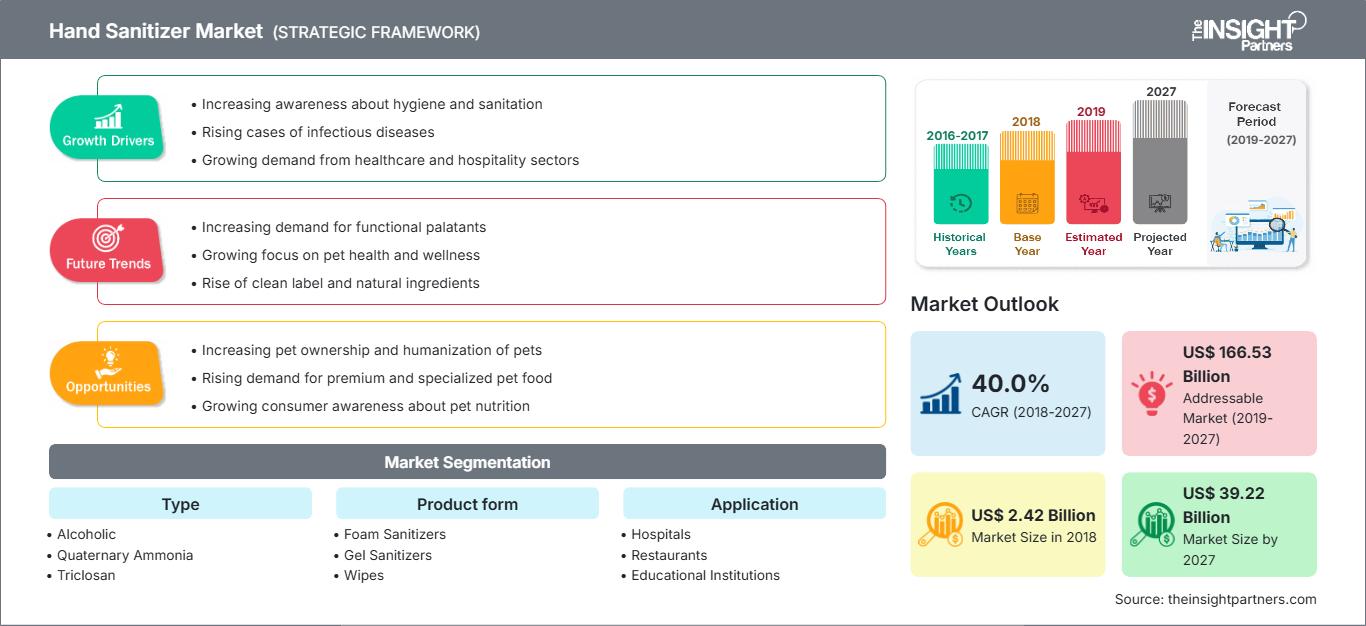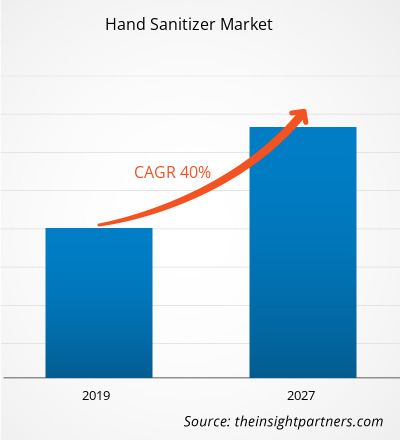2018 年洗手液市场价值为 24.211 亿美元,预计到 2027 年将达到 392.231 亿美元,预测期内的复合年增长率为 40.0%。
洗手液,也称为免洗洗手液或洗手消毒液,用于中和皮肤表面的细菌和微生物。它们经常用于职业和医疗保健环境中,因为这些环境中传播传染性病原体的风险要高得多。洗手液的功效取决于多种因素,例如洗手液的用量、使用频率和接触时间。然而,洗手液并不能代替彻底洗手。相反,它们被认为可以在无法洗手的情况下为用户带来洗手的一些好处。随着人们手部卫生意识的增强、生活水平的提高以及对自身健康的日益关注,洗手液的需求量大幅增加。洗手液在许多公共场所已变得无处不在,包括健身房、餐厅、医院、工厂、办公室、商场、电影院等。洗手液的普及很可能为洗手液行业带来巨大的发展机遇。洗手液使用方便,可随身携带,深受学龄儿童的喜爱。医疗保健行业是洗手液的消费大户,为洗手液行业带来了丰厚的收入。流感和其他传染病的频繁爆发是洗手液产品需求不断增长的原因之一。
自定义此报告以满足您的要求
您将免费获得任何报告的定制,包括本报告的部分内容,或国家级分析、Excel 数据包,以及为初创企业和大学提供超值优惠和折扣
洗手液市场: 战略洞察

- 获取本报告的主要市场趋势。这个免费样本将包括数据分析,从市场趋势到估计和预测。
市场洞察消费者对保持健康和卫生的意识不断增强
您将免费获得任何报告的定制,包括本报告的部分内容,或国家级分析、Excel 数据包,以及为初创企业和大学提供超值优惠和折扣
洗手液市场: 战略洞察

- 获取本报告的主要市场趋势。这个免费样本将包括数据分析,从市场趋势到估计和预测。
北美、欧洲和亚太地区大多数发达国家和发展中国家的消费者非常关注保持健康和卫生的生活方式。通过手掌传播的细菌通过口腔、鼻子、皮肤破损和眼睛进入人体。这些细菌会引起各种疾病,包括皮肤感染、眼部感染、感冒、胃痛等。为了预防这些疾病,洗手液可以大大帮助杀死高达 99% 的细菌、病菌和病毒。洗手液有液体、喷雾和湿巾形式,用于减少手上的传染源。除了生活方式和慢性疾病外,感冒、发烧和感染也是消费者中常见的传播疾病;因此人们非常关注预防这些疾病。各种非政府组织也在积极努力教育居住在偏远地区的人们保持健康和卫生。除此之外,主要洗手液制造商的营销和促销活动在提高消费者认知度方面发挥着重要作用。这些因素正在推动洗手液市场的增长。
类型洞察
根据用于制备洗手液的基础化学品,全球洗手液市场主要分为三大类,即酒精类、季铵类和三氯生类。2018 年,酒精类洗手液占据了全球洗手液市场的较大份额。然而,预计季铵类洗手液市场在预测期内的复合年增长率将最快。季铵化合物是强效的消毒化学品,常用于消毒湿巾、喷雾剂和其他家用清洁剂中,用于杀死细菌。这些化合物对细菌、酵母菌、霉菌和病毒非常有效。它们无腐蚀性,不会引起皮肤刺激,而且非常稳定。季铵盐类洗手液性能稳定,无论使用频率如何,其杀菌效力都不会随着时间的推移而减弱。由于季铵盐类洗手液的成本效益,许多制造商在生产洗手液时都使用它。这些因素正在影响季铵盐类洗手液市场的增长。
产品形态洞察
根据产品形态,全球洗手液市场细分为泡沫洗手液、凝胶洗手液、湿巾和喷雾洗手液。2018 年,凝胶洗手液占据洗手液市场的主导地位,市场份额最高,预计在预测期内将继续保持主导地位。然而,预计泡沫洗手液的复合年增长率将最快。泡沫洗手液的一大优势在于,在使用过程中,产品会紧贴手部。这种泡沫洗手液不像凝胶洗手液那样容易从手上滑落。制造商主要为消费者提供不含酒精的泡沫洗手液。这些洗手液可杀灭 99.9% 的常见细菌,保持双手清洁柔软。日托中心、健身中心、医院、厨房台面、学校和办公室周围等场所对这些产品的需求日益增长。
应用洞察
根据应用,全球洗手液市场可分为医院、餐厅、教育机构、家庭和其他。2018 年,医院部门以较高的份额引领了洗手液市场,预计在预测期内将继续保持主导地位。洗手液在全球所有医院和诊所中广泛使用,这推动了该市场的发展。在世界各地的医院,工作人员尽职尽责地涂抹洗手液以防止感染的传播。洗手液计量系统和分配器用于手术手部消毒。推荐使用含酒精的洗手液,并在医院中广泛使用。消毒剂作为预防措施的日益普及已被确定为推动市场增长的关键洗手液市场趋势之一。
分销洞察
全球洗手液市场进一步细分,分销渠道包括超市和大卖场、便利店、线上等。大卖场和超市在全球洗手液市场中占据最高市场份额,预计在预测期内将继续保持主导地位。大卖场和超市是自助商店,提供各种各样的洗手液产品,例如泡沫消毒剂、凝胶消毒剂、湿巾和喷雾消毒剂。这些种类繁多的产品以井然有序的方式摆放在不同的区域和货架上,以吸引顾客。这类商店为消费者提供来自不同品牌的丰富产品选择,并且与其他分销渠道相比价格更实惠。此外,类似的产品会排列在附近,方便买家在购买合适的产品之前比较不同的产品。这些地方的客流量不断增加,尤其是注重健康的买家,再加上各种品牌的洗手液产品以实惠的价格广泛供应,鼓励了顾客从大卖场和超市购买洗手液。
汉高股份公司、KGAA、利洁时集团、艺康、GOJO Industries, Inc. 等公司一直在实施各种战略,这些战略促进了公司的发展,进而带来了市场的各种变化。并购和产品发布是一些市场举措,也是这些公司为扩大市场份额而采取的一些活动。产品发布和并购等策略帮助他们发展了业务。
洗手液市场洗手液市场
The Insight Partners 的分析师已详尽阐述了预测期内影响洗手液市场的区域趋势和因素。本节还讨论了北美、欧洲、亚太地区、中东和非洲以及南美和中美洲的洗手液市场细分和地域分布。
洗手液市场报告范围
| 报告属性 | 细节 |
|---|---|
| 市场规模 2018 | US$ 2.42 Billion |
| 市场规模 2027 | US$ 39.22 Billion |
| 全球复合年增长率 (2018 - 2027) | 40.0% |
| 历史数据 | 2016-2017 |
| 预测期 | 2019-2027 |
| 涵盖的领域 |
By 类型
|
| 覆盖地区和国家 | 北美
|
| 市场领导者和主要公司简介 |
|
洗手液市场参与者密度:了解其对业务动态的影响
洗手液市场正在快速增长,这得益于终端用户需求的不断增长,而这些需求的驱动因素包括消费者偏好的不断变化、技术进步以及对产品优势的认知度不断提高。随着需求的增长,企业正在扩展产品线,不断创新以满足消费者需求,并抓住新兴趋势,从而进一步推动市场增长。

- 获取 洗手液市场 主要参与者概述
- 酒精类
- 季铵盐类
- 三氯生类
洗手液市场 - 按产品形态
- 泡沫消毒剂
- 凝胶消毒剂
- 湿巾
- 喷雾消毒剂
洗手液市场 - 按用途
- 医院
- 餐厅
- 教育机构
- 家庭
- 其他
洗手液市场 - 按分销渠道
- 超市/大卖场
- 便利店
- 线上
- 其他
洗手液市场 - 按地理
北美洲
- 美国
- 加拿大
- 墨西哥
欧洲
- 德国
- 法国
- 英国
- 俄罗斯
- 欧洲其他地区
亚太地区
- 澳大利亚
- 中国
- 印度
- 日本
- 亚太其他地区
中东和非洲
- 南非
- 沙特阿拉伯
- 阿联酋
- 中东和非洲其他地区
南美洲
- 巴西
- 阿根廷
- 南美洲其他地区美国
公司简介
- 汉高股份公司
- 利洁时集团
- 3M
- 艺康
- GOJO Industries Inc.
- 联合利华
- 喜马拉雅药业公司
- Godrej Industries Limited
- 宝洁
- 庄臣父子公司
- 历史分析(2 年)、基准年、预测(7 年)及复合年增长率
- PEST和SWOT分析
- 市场规模、价值/数量 - 全球、区域、国家
- 行业和竞争格局
- Excel 数据集
近期报告
客户评价
购买理由
- 明智的决策
- 了解市场动态
- 竞争分析
- 客户洞察
- 市场预测
- 风险规避
- 战略规划
- 投资论证
- 识别新兴市场
- 优化营销策略
- 提升运营效率
- 顺应监管趋势




















 获取免费样品 - 洗手液市场
获取免费样品 - 洗手液市场